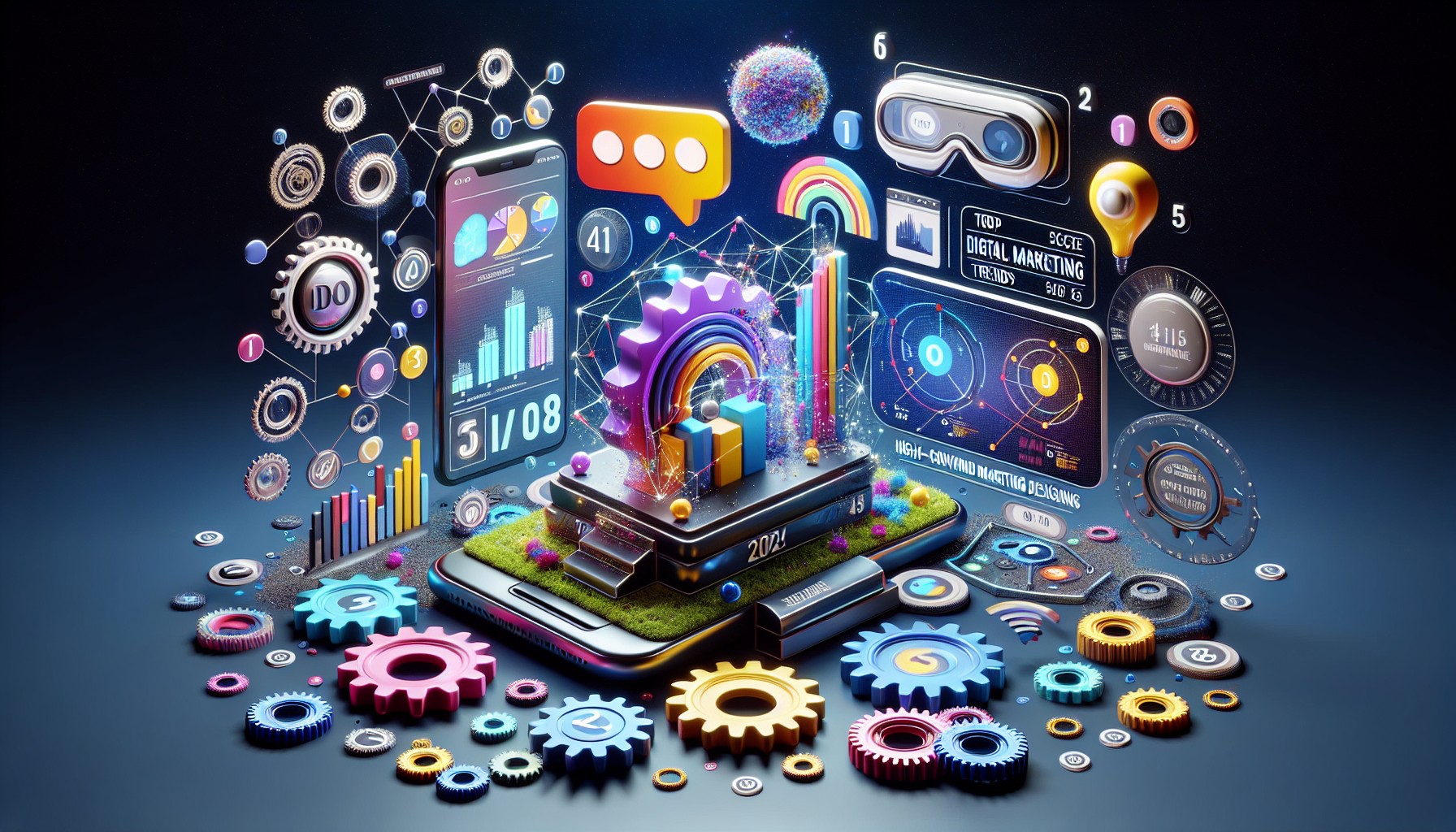Hello!
A new year is here. Pop the champagne, renew that gym membership, and let’s get started looking forward to 2024!
 People are optimistic about 2024, and not without reason – after several years of turbulence and uncertainty due to COVID and then high inflation, the economy seems to have found its footing, inflation has fallen, and consumer confidence is growing. Many businesses are looking to expand in 2024, and this often means investing in new marketing efforts.
People are optimistic about 2024, and not without reason – after several years of turbulence and uncertainty due to COVID and then high inflation, the economy seems to have found its footing, inflation has fallen, and consumer confidence is growing. Many businesses are looking to expand in 2024, and this often means investing in new marketing efforts.
But if you’re one of the many businesses looking to up your marketing spend in 2024, it’s important to know what you’re getting into.
The last year brought numerous changes to the world of digital marketing, and this coming year will be no different. In this blog, we’ll look at some of the major changes that the world of digital marketing can expect in 2024.
Without further ado, let’s look at the five biggest digital marketing trends of 2024.
#1: SGE (Search Generative Experience) on Search Engines
Let’s get the big one out of the way first.
We wrote about AI in the marketing world back in September. However, that article was mainly focused on things like using ChatGPT to write blogs – side note, when you’re pitching an article that you just used ChatGPT to write and think we can’t tell? Yes, we can – or asking it about good restaurants in the area.
This year, big search engines (at least, Google and Bing) will start rolling out their own generative AI-powered toolset, Search Generative Experience (SGE). This means that the search engines will start using AI to generate responses to search queries.
 It doesn’t take a digital marketing genius to realize that this comes with some serious potential to negatively impact website traffic.
It doesn’t take a digital marketing genius to realize that this comes with some serious potential to negatively impact website traffic.
After all, if Google or Bing will be answering search queries right at the top of the search engines results page (SERP), then why on earth would anyone scroll down to the blogs and web pages you’ve spent all this time optimizing and writing to answer their questions instead?
Let’s get this straight: SGE can, and will, negatively impact traffic for the majority of web sites. If your only understanding of SEO thus far has been “write something generic, fill it with keywords, publish and get blog traffic” then SGE will likely be a serious hit to your organic numbers.
The good news is that the cream of the crop can still rise to the top, and if that includes you, you can benefit instead.
Optimizing Your Site for SGE
We’ll publish a larger blog on SGE and how to make it work for your site, instead of against your site, later in January – it is, after all, perhaps the single biggest marketing trend of 2024. For the time being, though, consider that search engines prioritize one thing above all else in their SGE algorithms: expertise.
 Generative AI is not at the stage where it can come up with things from scratch. (And it may never be). It is, fundamentally, a very, very, very advanced autocomplete algorithm.
Generative AI is not at the stage where it can come up with things from scratch. (And it may never be). It is, fundamentally, a very, very, very advanced autocomplete algorithm.
Google, Microsoft, and the rest of the competitors in the space know that if the only content they scrape for their SGE is a million blogs regurgitated by ChatGPT, the SGE answers will be bland, unhelpful, or worst of all, blatantly incorrect.
This means that Google and Microsoft will want to highlight the best sites and the most authoritative answers in their SGE results, which means that if you want to optimize your content for SGE, you need to be this authoritative expert.
 Here are just some of the things you can do to make it more likely that your site will be not just chosen by SGE, but will appear next to it as a trusted, authoritative source:
Here are just some of the things you can do to make it more likely that your site will be not just chosen by SGE, but will appear next to it as a trusted, authoritative source:
- Produce quality content. At the end of the day, there’s no getting around this one: You need to ensure your content is high-quality, informative, and highly relevant to the needs of your target audience. Focus on providing clear and concise answers to specific questions your audience might face.
- Focus on EEAT (Experience, Expertise, Authoritativeness, and Trustworthiness). The EEAT criteria have been used by search engines for a while, and now they are going to be even more important than ever before. Establish your brand as credible – both as a business and as an individual. Make it clear that you are an expert on the subject, you know what you’re talking about, and people should read what you have to say. You should include author bios and make sure you’re publishing under your own name as much as possible.
- Use keywords naturally. “Keyword stuffing” is going to be more of a red flag than ever before. Use natural language wherever possible for ease of reading. Also, shift your focus from isolated keywords to longer, more conversational phrases – that is, long-tail keywords – that better reflect user intent, since these more closely align with how users will ask SGE questions.
If done right, your website can actually benefit from SGE. Here’s an example from one of our own clients for how it can look when Google SGE decides your site is worth promoting.
But if you’re not updating your content to be highly relevant and up to date, and you aren’t working hard to provide engaging, authoritative content, you might be doomed to have SGE start eating your lunch.
#2: The Rise of Snackable Content
 Statistically, even though we’re not even 1000 words into this blog post yet, if you were the average internet user, you’d have stopped reading long ago.
Statistically, even though we’re not even 1000 words into this blog post yet, if you were the average internet user, you’d have stopped reading long ago.
Our attention spans are shot. Millennials are accustomed to two screens, if not more, at just about all times – for Gen Z and Gen Alpha, it’s arguably worse. Is there any shock that 2023 saw major platforms trying to catch up with TikTok by pushing YouTube Shorts and Instagram Reels – designed to deliver bite-sized bits of content that entertain, inform, and engage with viewers in seconds if not minutes.
This sort of micro-video content isn’t new. It was done previously, and even shorter, by Vine – but TikTok and its followers have achieved the sort of dominance in the new online ecosystem that Vine never did. Figuring out how to create this content for your brand and get it shared by users is going to be vital.
Does Snackable Content Work for B2B Marketers, Too?
So, what if your brand isn’t, you know, sexy? What if you are the world’s best maker of a specific type of ball bearing used in industrial manufacturing, and therefore TikTok doesn’t exactly seem like a great spot for you to be making content for?
That doesn’t mean you can’t create snackable content. It just means that your content should be still tailored to your target audience that might not have a great attention span anymore.
 For instance, you could rely on slick infographics or charts that are easily digestible, which can be similarly understood and re-shared on social media as bite-sized pieces of content in between tasks or while getting coffee.
For instance, you could rely on slick infographics or charts that are easily digestible, which can be similarly understood and re-shared on social media as bite-sized pieces of content in between tasks or while getting coffee.
Don’t forget: If you’re a B2B marketer, you’re not just selling to brands and businesses. Businesses don’t get on sales calls with your team – people do.
You’re marketing to individuals at these companies, so following the trend of making bite-sized snackable content is great for both B2B and B2C marketers.
#3: “Dark Social” Will Dominate
And speaking of which, here’s another topic we wrote about late last year: The growing importance of dark social.
What is dark social, exactly? We wrote that blog, too – but to sum up, dark social refers to the various social interactions that happen outside of places where they’re easily tracked. Conversations at the water cooler, conversations on Slack or Discord channels, a quick link sent in an email to a friend are all examples of dark social in marketing.
 Dark social is especially important for B2B marketers, especially those embarking on demand-generation campaigns that are designed to expand a brand’s customer base. However, it shouldn’t be neglected for B2C marketers either as people search for expertise and opinions they trust.
Dark social is especially important for B2B marketers, especially those embarking on demand-generation campaigns that are designed to expand a brand’s customer base. However, it shouldn’t be neglected for B2C marketers either as people search for expertise and opinions they trust.
After all, people are more likely to trust opinions from sources they personally know, which is one of the things that makes word-of-mouth advertising so effective, and “dark social” is word of mouth updated for the modern era.
That holds true whether you’re sending an email with a link to an interesting podcast or product demo to your boss or to your brother-in-law because it’s about a hobby he enjoys.
Understanding dark social, understanding how to harness it and how to track it, is going to be a key factor of demand-generation marketing in 2024 and beyond.
#4: Streaming Advertising Strikes Back
In 2024, Amazon will start showing ads on video content for Amazon Prime subscribers on a lower payment tier.
They won’t be alone, either. As the worldwide economy adjusts to a new paradigm of higher interest rates (especially impactful on tech businesses) and other economic hurdles, expect to see other streaming sites either following suit or taking the route of Netflix and increasing prices.
 Combine this news with reports that Google has started cracking down on ad blockers, and a big picture soon emerges: Streaming providers are looking to capture more revenue by putting ads in front of video content, whether it’s streamers playing games on YouTube or watching the newest season of whatever hit show Amazon is cooking up.
Combine this news with reports that Google has started cracking down on ad blockers, and a big picture soon emerges: Streaming providers are looking to capture more revenue by putting ads in front of video content, whether it’s streamers playing games on YouTube or watching the newest season of whatever hit show Amazon is cooking up.
While ads in front of streaming content is nothing new, it seems quite likely that they will be far more prevalent moving forward than they had been previously.
Before, ads on streaming platforms tended to be limited to the lowest tier of service, or even free accounts; now, the paradigm seems like it will be “everyone gets ads, except for the highest tier of service.”
For advertisers who work with video content, this represents a potentially lucrative opportunity – as well as a potential pitfall.
The upside is obvious: for marketers, we get new opportunities to get our brands in front of viewers’ eyeballs. More opportunity for marketing touch points means more opportunity for sales, especially in the B2C world.
But let’s not forget a key point: A lot of viewers don’t like ads! The reason ad-free streaming services became so popular – the reason people use ad blockers in the first place – is that people get annoyed when their content is interrupted by an obtrusive unskippable ad.
 It might be tempting for marketers to see the rise of advertising on streaming platforms and lick their chops, but restraint is the key here, because you don’t want to annoy viewers into having a negative opinion of your brand, either.
It might be tempting for marketers to see the rise of advertising on streaming platforms and lick their chops, but restraint is the key here, because you don’t want to annoy viewers into having a negative opinion of your brand, either.
One key digital marketing trend of 2024, therefore, is likely to be the advertising equivalent of snackable content – micro-ads of 5-10 seconds that aren’t skippable but don’t need to be, because they’re short enough to be much less disruptive.
Whether it’s for unique content or ads on streaming platforms, learning to take advantage of shorter attention spans and be succinct in your messaging will be a vital skill for advertisers to master in 2024 and beyond.
#5: Navigating Privacy Concerns
In addition to opportunities, 2024 is inevitably going to come with challenges. One tightrope that advertisers are going to have to learn to walk in this year is growing consumer concern about privacy and how much of our digital lives are being monitored and tracked – even if it’s just by advertisers who want to connect them with brands they’d love.
In June of last year, Apple introduced some automatic link-tracking removalcapabilities in iOS 17. Google is following suit, starting its rollout of tracking-cookie removal earlier this month.
 Tracking cookies, of course, were vital tools used by PPC advertisers like us to assess campaigns, to remarket and retarget to audiences that were more likely to be receptive to our messaging.
Tracking cookies, of course, were vital tools used by PPC advertisers like us to assess campaigns, to remarket and retarget to audiences that were more likely to be receptive to our messaging.
This trend towards privacy, which is driven as much by consumer concern as it is by EU regulations, will make it significantly more difficult for advertisers to track our campaigns or serve highly targeted ads.
While Google says that it will still allow advertisers to generally target segmented audiences by things like demographics and interest, this change will invariably make it more difficult to do the kind of hyper-targeted advertising that many of us are accustomed to.
Unfortunately, there is little in terms of easy solutions to this new development; a move towards consumer privacy rights was likely inevitable over time.
Marketers should expect to rely on alternative ways of tracking campaigns – for instance, using different landing pages entirely for different campaigns rather than tracking URLs, or simply having a “where did you hear about us?” form on any landing page or other conversion screen.
Either way, navigating this change in digital advertising will be a big task ahead of marketers in 2024.
Honorable Mentions: Influencer Marketing, UGC, Voice Search
 While these have been around for some time, and thus possibly don’t belong in a “top digital marketing trends of 2024” article, it’s worth noting that these are all vital pieces of B2B and B2C advertising in the current age, and if your marketing agency isn’t working on mastering them yet, you’re falling behind and need to catch up!
While these have been around for some time, and thus possibly don’t belong in a “top digital marketing trends of 2024” article, it’s worth noting that these are all vital pieces of B2B and B2C advertising in the current age, and if your marketing agency isn’t working on mastering them yet, you’re falling behind and need to catch up!
- Influencer marketing: As we mentioned before with dark social, people trust opinions and information from people they know and trust. Influencers have access to broad audiences that like, value, and trust their opinions – so working with influencers in various fields is a must. An endorsement from a trusted influencer can be almost as impactful as an endorsement from a trusted friend or family member.
It can be tempting to think of “influencers” as just a B2C marketing strategy, but that’s narrow-minded. Influencers exist in every industry, in every field – and as a digital advertiser, it’s your job to find them and get them ready to promote your brand’s products or services. - User Generated Content (UGC): As with the above point, this is something else that, when you break it down, comes down to a simple word – trust.
Think about some of the other entries on this list. Privacy concerns becoming more widespread so that Google and Apple are working on gutting tracking cookies that they use to sell ads, Google in an endless arms race to beat ad-blockers – what these come down to is an inherent skepticism of being marketed to. Bad actors have made it so that ads are often treated with suspicion, like every marketer is trying to sell a bill of goods, or convince a customer to buy something they fundamentally don’t need. (And, let’s be honest, some unethical marketers actually do these things.)
UGC, which shows real people using your products or services in real ways – or telling others about the impacts your offering has had on them – is a way of winning back some of that trust. It tells potential customers that no, you’re not just promising something you can’t deliver. As with dark social or influencer marketing, UGC delivers a sense of authenticity that people respond well to in both B2B and B2C environments. If you can harness the power of UGC, you should be doing so. - Voice Search: I can’t tell you how often my household has us asking a question of Alexa, Siri, or Google Assistant – look, we have a lot of different operating systems, OK – for both informative as well as commercial purposes. Whether it’s asking the kitchen Alexa the proper conversions because someone’s New Year’s resolution was learning how to bake, or asking Google for the best Thai restaurant within 5 miles, voice search is how many people interact with the internet these days.
This means that advertisers should be following suit. If you want your business to be showing up as a result when people search for relevant information, you should think about how a real person might address this search to their digital assistant of choice. - Conversational question prompts will be more effective than awkward keywords any day of the week.
 Between the rise of native tracker-cookie blocking and SGE, 2024 is likely to be a year of great change in the world of digital marketing. Adapting to these changes will not be easy, but as with all changes, they bring with them opportunity as well.
Between the rise of native tracker-cookie blocking and SGE, 2024 is likely to be a year of great change in the world of digital marketing. Adapting to these changes will not be easy, but as with all changes, they bring with them opportunity as well.
Brands and digital marketers who can adapt to these changes will be well-positioned for success; those that can’t will struggle to find success and likely see big hits to ROI.
Also read:
- 7 Best Technologies that could Replace Data Science in 2023
- 5 Steps to Turn Blog Readers into Customers
- Working, Studying & Being Healthy. How to Balance it?
Thank you!
Join us on social media!
See you!






